The table and charts below, show Spokane auto accident data from WSDOT between 2015 and 2023. The numbers reveal an overall upward trend in fatal and suspected serious injury incidents, peaking at 26 in 2021, but remaining high at 18 in 2023. Similarly, incidents involving suspected serious injuries increased from 59 in 2015 to 108 in 2022 and 103 in 2023. This upward trend in serious and fatal crashes highlights the importance of the ongoing efforts needed to improve road safety measures and address factors contributing to these types of accidents in Spokane.
| Fatal | Suspected Serious Injury | Suspected Minor Injury | Possible Injury | No Apparent Injury | Total Crashes | |
|---|---|---|---|---|---|---|
| 2015 | 16 | 59 | 345 | 1,005 | 2,244 | 3,669 |
| 2016 | 7 | 65 | 362 | 1,155 | 2,301 | 3,890 |
| 2017 | 15 | 68 | 300 | 1,091 | 2,264 | 3,738 |
| 2018 | 7 | 73 | 299 | 1,066 | 2,340 | 3,785 |
| 2019 | 10 | 63 | 272 | 1,202 | 2,837 | 4,384 |
| 2020 | 18 | 88 | 350 | 769 | 2,449 | 3,674 |
| 2021 | 26 | 90 | 536 | 819 | 2,662 | 4,133 |
| 2022 | 15 | 108 | 505 | 808 | 2,626 | 4,062 |
| 2023 | 18 | 103 | 413 | 568 | 1,780 | 2,882 |
| Totals | 132 | 717 | 3,382 | 8,483 | 21,503 | 34,217 |
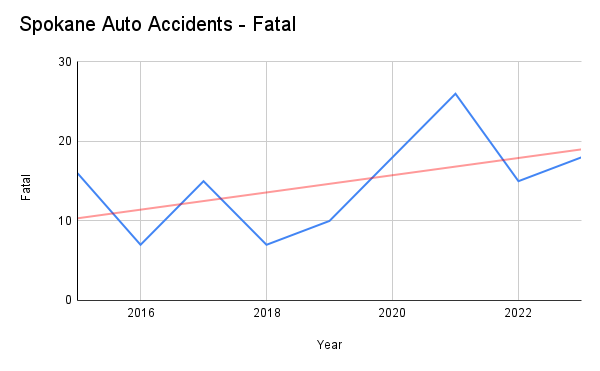
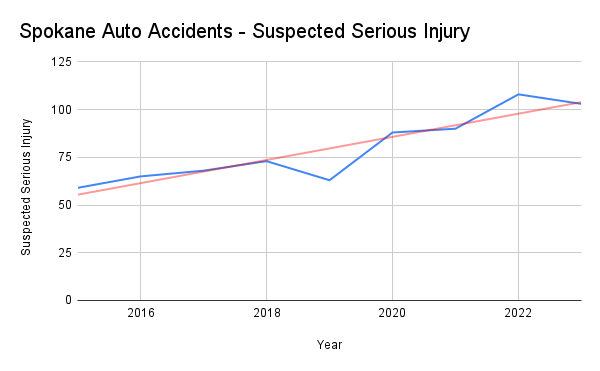
Crash Data Comparison Between Spokane and Tacoma
In looking at crash data for a similar-sized Washington city, Tacoma, WSDOT shows similar upward trends to those observed in Spokane. Suspected serious injury crashes shows similar rising numbers to Spokane, but fatal accidents in Tacoma were 38.6% higher with 183 between 2015 and 2023, compared to Spokane’s 132 incidents. This in spite of Tacoma’s slightly smaller population.
| Fatal | Suspected Serious Injury | Suspected Minor Injury | Possible Injury | No Apparent Injury | Total Crashes | |
|---|---|---|---|---|---|---|
| 2015 | 18 | 72 | 334 | 1,113 | 3,221 | 4,758 |
| 2016 | 20 | 66 | 293 | 1,206 | 3,529 | 5,114 |
| 2017 | 12 | 85 | 343 | 1,161 | 3,675 | 5,276 |
| 2018 | 15 | 76 | 337 | 1,148 | 3,651 | 5,227 |
| 2019 | 18 | 75 | 297 | 1,084 | 3,265 | 4,739 |
| 2020 | 18 | 71 | 263 | 893 | 2,655 | 3,900 |
| 2021 | 23 | 103 | 360 | 1,045 | 3,443 | 4,974 |
| 2022 | 24 | 104 | 309 | 929 | 3,222 | 4,588 |
| 2023 | 35 | 123 | 257 | 768 | 2,292 | 3,475 |
| Totals | 183 | 775 | 2,793 | 9,347 | 28,953 | 42,051 |
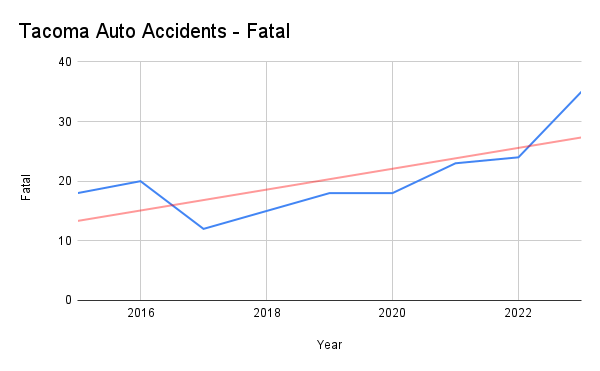
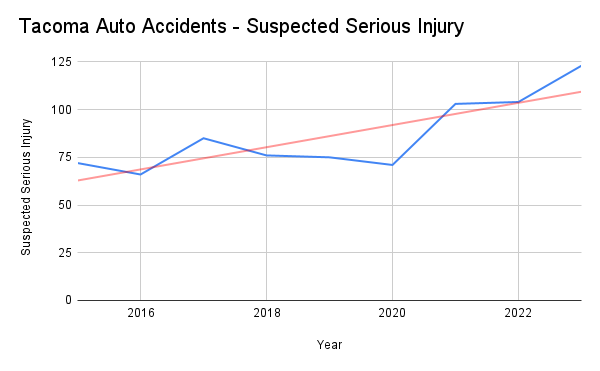
Although both Spokane and Tacoma have major highways running through them, I-90 and I-5 respectively, the majority of accidents, including fatal accidents happen off the interstates.
Spokane vs. Tacoma: A Road Safety Comparison
Traffic Characteristics:
- Spokane: Spokane’s road network includes a mix of urban and rural roads, with varied terrain and topographical features. Major highways such as Interstate 90 (I-90) traverse the city, connecting it to other regions.
- Tacoma: Tacoma, strategically located along Interstate 5 (I-5), boasts urban infrastructure such as bridges, tunnels, and elevated roadways. The city’s position as a major port hub influences traffic patterns, including heavy truck traffic.
Traffic Volume and Density:
- Spokane: While Spokane experiences significant traffic volume, particularly on major highways, it generally has lower traffic density compared to Tacoma.
- Tacoma: Tacoma’s proximity to Interstate 5 results in high traffic volume and congestion, reflecting its role as a major urban center and transportation hub.
Safety Challenges:
- Spokane: Challenges in Spokane may stem from varied terrain and road conditions, with factors such as weather, topography, and infrastructure influencing road safety.
- Tacoma: Tacoma faces unique safety challenges associated with urban infrastructure complexity, port traffic, and commercial activity, contributing to higher accident rates and fatalities.
Community Initiatives:
- Spokane: Community initiatives in Spokane focus on promoting road safety awareness, implementing infrastructure improvements, and enhancing law enforcement efforts to reduce accidents and fatalities.
- Tacoma: Tacoma’s initiatives prioritize addressing the specific challenges posed by urban infrastructure, port traffic, and commercial activity through targeted interventions and collaborative partnerships.
While both cities share common road safety goals, each faces distinct challenges shaped by its unique geography, infrastructure, and traffic characteristics. Understanding these differences can inform tailored approaches to improving road safety and reducing accident rates in Spokane and Tacoma, ultimately enhancing the overall safety and well-being of residents and visitors alike.
Automobile Crash Data from the State of Washington
Comparing all WSDOT crash data from Washington state to the data from Spokane and Tacoma, it is clear that the entire state of Washington has experienced a rising trend in fatal and suspected serious injury accidents. The tables and charts below show this trend.
- Fatalities: The number of fatal accidents for all Washington state data shows some fluctuations over the years but generally exhibits an increasing trend, peaking at 696 incidents in 2023. This steady rise in fatal accidents suggests a concerning trend that warrants further investigation into the underlying causes and potential preventive measures.
- Suspected Serious Injuries: Similar to fatalities, suspected serious injury crashes demonstrate an increasing trend, with a notable spike from 2021 onwards. This escalation indicates a rising number of severe accidents resulting in serious injuries, highlighting the need for enhanced safety measures and interventions to mitigate the risk of severe outcomes on Washington’s roadways.
| Fatal | Suspected Serious Injury | Suspected Minor Injury | Possible Injury | No Apparent Injury | Total Crashes | |
|---|---|---|---|---|---|---|
| 2015 | 497 | 1,752 | 8,942 | 25,834 | 79,981 | 117,006 |
| 2016 | 506 | 1,893 | 8,550 | 27,196 | 84,186 | 122,331 |
| 2017 | 532 | 1,916 | 8,175 | 26,179 | 84,326 | 121,128 |
| 2018 | 489 | 1,928 | 7,742 | 25,036 | 80,829 | 116,024 |
| 2019 | 517 | 1,924 | 7,362 | 23,545 | 78,327 | 111,675 |
| 2020 | 536 | 2,065 | 8,137 | 15,249 | 60,332 | 86,319 |
| 2021 | 596 | 2,499 | 10,183 | 16,589 | 73,417 | 103,284 |
| 2022 | 690 | 2,639 | 10,929 | 16,001 | 73,018 | 103,277 |
| 2023 | 696 | 2,834 | 9,243 | 12,121 | 55,821 | 80,715 |
| Totals | 5,059 | 19,450 | 79,263 | 187,750 | 670,237 | 961,759 |
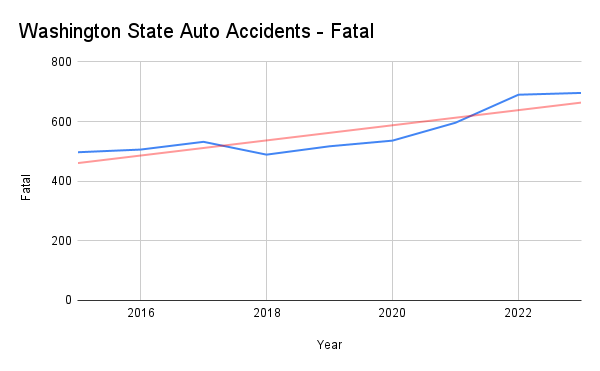
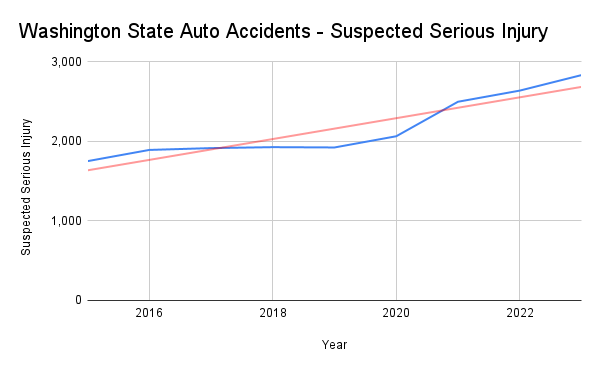
Negligence in Auto Accidents
In many fatal and serious injury car crashes, negligence on the part of one or more drivers is a significant factor. Negligence occurs when a driver fails to exercise reasonable care, resulting in harm to others on the road. Common examples of negligence in car accidents include:
- Distracted Driving: Distractions such as texting, talking on the phone, eating, or adjusting the radio can divert a driver’s attention from the road, leading to accidents.
- Speeding: Exceeding the posted speed limit or driving too fast for road conditions reduces a driver’s ability to react to hazards and increases the severity of accidents.
- Impaired Driving: Driving under the influence of alcohol, drugs, or certain medications impairs judgment, coordination, and reaction time, significantly increasing the risk of accidents.
- Reckless Driving: Behaviors such as aggressive driving, tailgating, weaving in and out of traffic, and disregarding traffic signals or signs can lead to collisions with fatal or serious injuries.
- Fatigue: Driving while fatigued or drowsy can impair a driver’s ability to stay alert and react quickly to changing road conditions, increasing the likelihood of accidents.
- Weather Conditions: Adverse weather conditions such as rain, snow, ice, or fog can reduce visibility and traction, making it more challenging to control vehicles and avoid accidents.
- Vehicle Defects: Malfunctions or defects in vehicle components such as brakes, tires, steering systems, or safety features can contribute to accidents resulting in fatal or serious injuries.
Determining negligence in Spokane car accidents often involves investigating the circumstances leading up to the crash, gathering evidence such as witness statements, police reports, and surveillance footage, and evaluating whether a driver breached their duty of care to others on the road. Negligence can form the basis for legal claims seeking compensation for injuries, medical expenses, lost wages, and other damages resulting from car accidents.
The Car Accident Lawsuit Process
A car accident lawsuit typically begins when an individual injured in a car accident, known as the plaintiff, files a claim against the at-fault party, known as the defendant, seeking compensation for damages resulting from the accident. Here’s an overview of how a car accident lawsuit typically works:
- Initial Consultation: The injured party consults with a personal injury attorney to discuss the details of the accident, the extent of their injuries, and potential legal options. During this consultation, the attorney evaluates the case’s merits and advises the individual on the next steps.
- Investigation: The attorney conducts a thorough investigation into the circumstances surrounding the accident. This may involve gathering evidence such as police reports, witness statements, photographs of the accident scene, medical records, and any other relevant documentation.
- Determining Liability: The attorney assesses liability by determining who was at fault for the accident. Liability may be established based on factors such as negligent driving behavior, violations of traffic laws, or other negligent actions that contributed to the accident.
- Filing a Claim: If the attorney determines that there are grounds for a lawsuit, they file a claim on behalf of the plaintiff against the at-fault party or parties. The claim outlines the plaintiff’s allegations of negligence and the damages they seek to recover.
- Discovery: Both parties engage in the discovery process, during which they exchange information and evidence related to the case. This may include written interrogatories, requests for the production of documents, and depositions of witnesses and parties involved in the accident.
- Negotiation: Before trial, the attorneys for both parties may engage in settlement negotiations to resolve the case out of court. Negotiations typically involve discussions of liability, the extent of damages, and potential settlement amounts.
- Mediation or Arbitration: If the parties are unable to reach a settlement through negotiation, they may participate in mediation or arbitration, where a neutral third party facilitates discussions and helps the parties reach a resolution.
- Trial: If settlement negotiations or alternative dispute resolution methods are unsuccessful, the case proceeds to trial. During the trial, both parties present evidence, call witnesses and make arguments before a judge or jury, who ultimately determine liability and award damages if applicable.
- Appeal: Following a trial verdict, either party may choose to appeal the decision if they believe legal errors were made during the trial process.
- Resolution: Once a verdict is reached or a settlement is agreed upon, the case is resolved, and the plaintiff receives compensation for their damages, including medical expenses, lost wages, pain and suffering, and other losses resulting from the accident.
Throughout the car accident lawsuit process, the plaintiff’s attorney advocates on their behalf, working to protect their legal rights and pursue fair compensation for their injuries and losses.
Why Crash Data Matters
The examination of car accident statistics in Spokane, compared to Tacoma and statewide data for Washington, sheds light on the complexities and challenges of road safety. While both Spokane and Tacoma experience similar upward trends in fatal and serious injury accidents, each city presents its unique circumstances, including differences in major roadways and terrain.
Despite efforts to improve road safety measures and reduce accidents, too many lives are being lost. The persisting upward trends show the need for the ongoing need for comprehensive strategies to address factors contributing to accidents, such as distracted driving, speeding, and impaired driving. Additionally, the comparison between Spokane and Tacoma emphasizes the importance of tailored approaches to address specific risk factors unique to each community.
Moving forward, continued and effective collaboration among policymakers, law enforcement agencies, transportation authorities, and community stakeholders is absolutely necessary to implement effective solutions and create safer roadways for all residents. By raising awareness, promoting responsible driving behavior, and investing in infrastructure improvements, we can strive towards reducing the incidence of car accidents and protecting the well-being of individuals and families in our communities.
